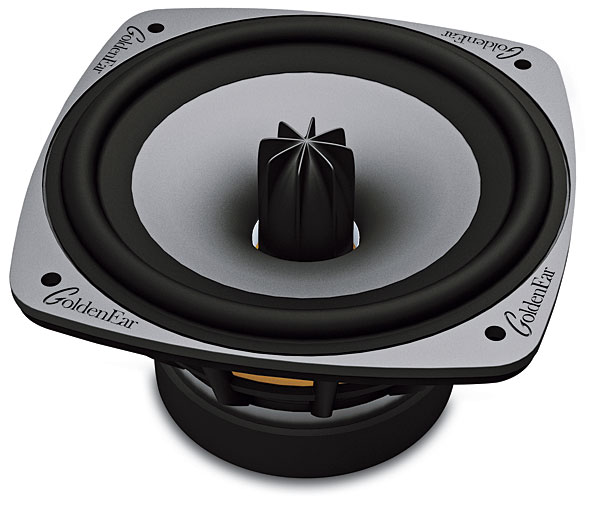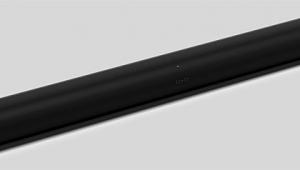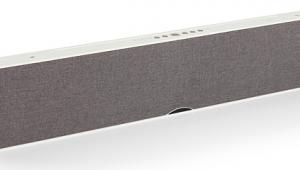GoldenEar Technology SuperCinema 3D Array Soundbar System Page 2
A Lot of Night Music
Dave Kakenmaster, GoldenEar Technology’s western sales manager, made the long trek to my house to help set up the system and make sure everything was working properly since this was one of the first SuperCinema 3Ds off the production line. The soundbar uses keyhole slots for mounting on the wall. There’s also a stand that props the soundbar at the right angle if you’re using it on a shelf. The binding posts for the three channels are recessed into the back of the SuperCinema 3D’s cabinet, allowing the soundbar to be mounted flat against the wall. However, those binding posts are extremely close together, making it somewhat challenging to sneak bare speaker wire in between and tighten them down. If the SuperCinema 3D is custom installed with wiring in the wall, having the binding posts close together makes it easy to finish out, especially if you use banana plugs on the end of the speaker cables. On the other hand, if the speaker is mounted on the wall with surface-mounted speaker wire running to it (hidden with paintable wire molding, for example), you’ll need a couple of spacers between the back of the SuperCinema 3D and the wall to provide enough room for even the most slender speaker wire to slip in from underneath. Obviously, this isn’t an issue if you use the foot stand.
I mentioned Kakenmaster’s visit because he’s extremely into music and can always be counted on to bring awesome demo material with him. So, naturally, once everything was in place, we decided to listen to a brief musical interlude before moving on to what is the soundbar’s raison d’être—playing movie soundtracks. Four hours later, when it was well past time to leave for dinner at the unique “we’ll shoot it if you’ll eat it” restaurant half a dozen miles from my house, Kakenmaster and I had still not put a Blu-ray movie in the PS3. Remarkably, we had spent the entire time listening to twochannel music playing through a flippin’ soundbar! The width and openness of the soundstage was absolutely incredible, stretching farther across the front of the room than what some freestanding speakers can produce. All with imaging that was Gibraltar-stable rock solid. Sandy Gross calls the impressive musical performance the result of “special 3D image optimization technology” in the SuperCinema 3D. I’d call it simply spectacular.

There are so many exceptional two-channel examples I could give (after all, it was hard not to listen—and then listen some more—to music on the SuperCinema 3D). Ha Ha Tonka’s a cappella version of “Hangman” (Buckle in the Bible Belt) absolutely filled the entirety of the front soundstage, while the echoes of lead singer Brian Roberts’ voice at times seemed to reverberate from the rear of the room. The upper registers of Oscar Peterson’s piano in “Body and Soul” (from a high-res download of Oscar Peterson: Unmistakable—Zenph Re-performance I found on iTrax) were crisp and light without any harshness—a sound quality very reminiscent of a fine electrostatic speaker. Pearl Jam’s “Thin Air” (Binaural) begins with an isolated guitar solo dead center; but as the vocals, drums, and other instruments come in, the soundstage explodes across the front of the room, stretching almost to the sides. Another iTrax download, John Gorka’s “Writing in the Margins,” also presented a dramatically wide soundstage with Gorka’s voice totally focused in the center and pulled slightly forward. This track, as well as the one from Pearl Jam, also demonstrated how smoothly the ForceField 3 subwoofer blended with the SuperCinema 3D.
Wow, It Does Movies, Too!
Regarding the blend of the ForceField 3 with the SuperCinema 3D, I played around quite a bit with the crossover points before I was totally satisfied. Originally, as was suggested, I set the crossover for the SuperCinema 3D at 120 hertz. For most of the time, that setting worked quite well. But since the ForceField 3 was placed a couple of feet to the left of the SuperCinema 3D, there were instances when there was a noticeable smearing or stretching to the left of drums and other low-frequency instruments. That’s because the higher the frequency you cross over a subwoofer, the more localizable it becomes. Resetting the crossover point at 100 Hz eliminated the problem, although I eventually settled on 90 Hz because I felt that at that frequency, voices in the center channel gained important heft and authority.
Speaking of movies, in the extended version of Sucker Punch, during the mission to steal secret plans from German steampunk automatons, the wide and expansive front soundstage seemed to stretch and melt into the SuperSat 3s in the rear. Shots fired from the back to the front (and vice versa) traveled through the room so realistically, it almost made me duck. Echoes from machine guns were everywhere, and it was very eerie to hear the steam rushing out of a dead soldier move from the front to the back of the soundfield. The subwoofer created an ominous, theatrical, and very effective low underpinning to the soundtrack as a red-eyed German appears onscreen before entering the bunker with the plans. Finally, as the bunker begins to collapse, the reverberations surround the room as one continuous whole. (I had no idea what the rest of the movie was about, but it definitely made me want to watch more.) In The Hunger Games, a movie filled to the brim with both effects and music in the surrounds, as Katniss gets too close to the edge of the simulation, the fireballs that are thrown at her fly directly overhead to the rear as the sounds of her frantic scrambling through the forest fill the front soundstage. The ForceField 3 subwoofer is extremely convincing, reproducing both the ever-present bass rumble and the explosions of the fireballs. Finally, early in Safe House, there’s a car chase during which two cars go from rear to front on each side of the room around the viewer. The smoothness of the transition came from both the use of HVFR tweeters in the SuperSat 3s and the SuperCinema 3D, as well as the SuperCinema 3D’s exceptionally wide soundstage. Not much later, the ability to create such astounding width is especially noticeable as Matt and Tobin exit the small confines of the car and begin walking in the open expanse filled with people outside the stadium.
On a lark (I have several lying around), just prior to packing up the system, I disconnected the SuperSat 3s being used as discrete surrounds and configured my Anthem AVM 50v’s speaker settings to No Surrounds. With the surround information down-mixed into the front left and right channels, the extremely wide soundstage produced by the SuperCinema 3D expanded even farther, to the point of wrapping down the sides of the room to almost just past my head. Watching a bit of Transformers: Dark of the Moon (I thought it was a movie about Pink Floyd), I was amazed at how good the simulated surround effect was—making the SuperCinema 3D one of the better simulated-surround soundbars I’ve heard, although part of the success does go to the downmixing in the preamp.
Instant Classic
There’s no doubt about it. The GoldenEar Technology SuperCinema 3D Array is a stunningly ear-catching accomplishment that redefines the very notion of what an LCR soundbar can achieve.
Of course, that doesn’t mean it’s perfect for everyone; and with its required accompaniment, it’s certainly not the solution for the person who dislikes traditional home theater gear. On the other end of the spectrum, I wouldn’t trade out a pair of GoldenEar Triton Three towers for the SuperCinema 3D, either. As good as the SuperCinema 3D is, it can’t create the amount of mindbending front-to-back depth in the soundstage that a great pair of freestanding speakers can. But, if a standard soundbar is what you need or want, for your main system or perhaps in a bedroom or secondary theater system, the GoldenEar Technology SuperCinema 3D Array is a must-listen-to, top-of-the-shoppinglist, soundbar-to-beat contender that’s destined to become a classic in the annals of home theater speakers (if such annals ever get written). In other words, when it comes to soundbars, awesome just got redefined.
- Log in or register to post comments




































































